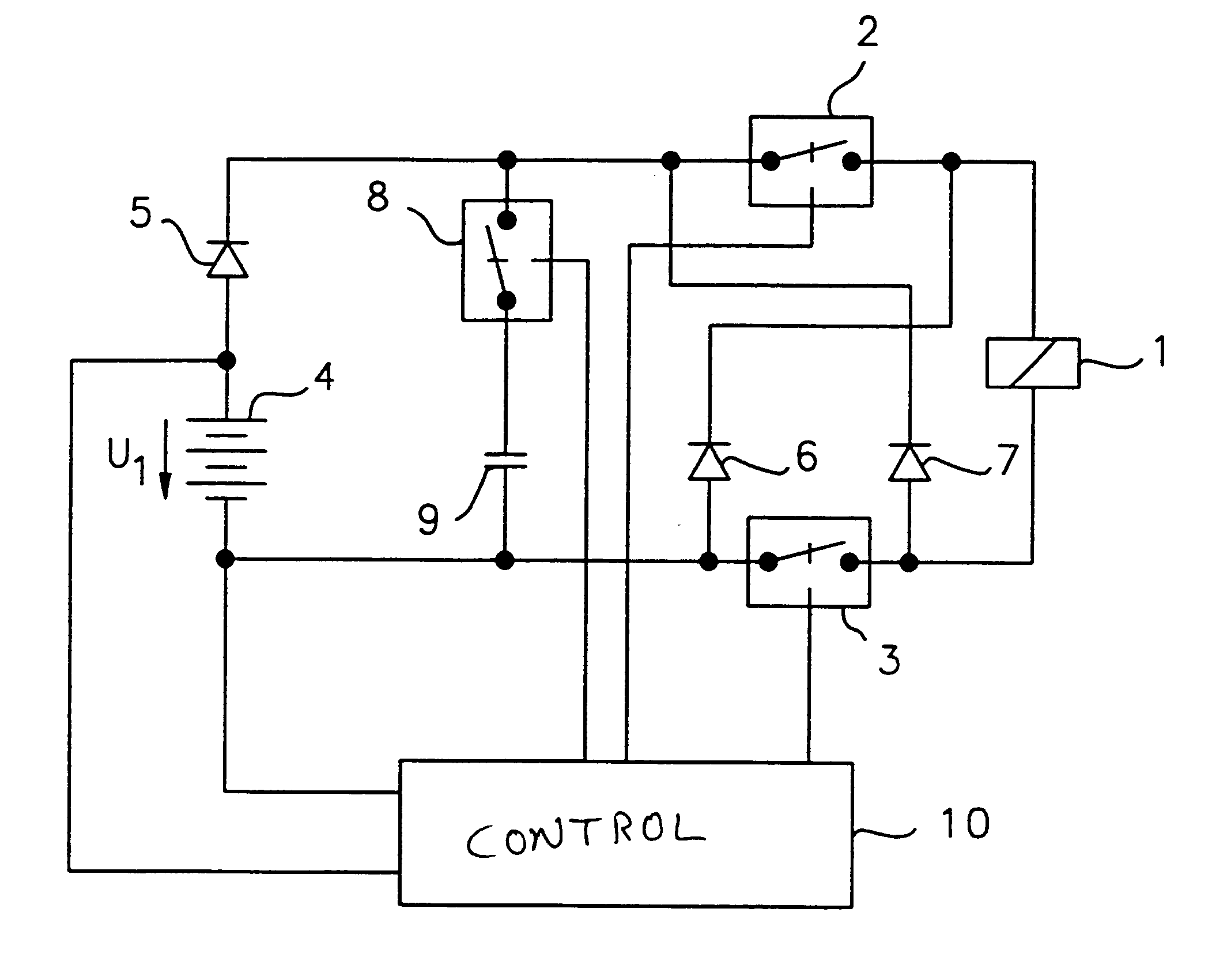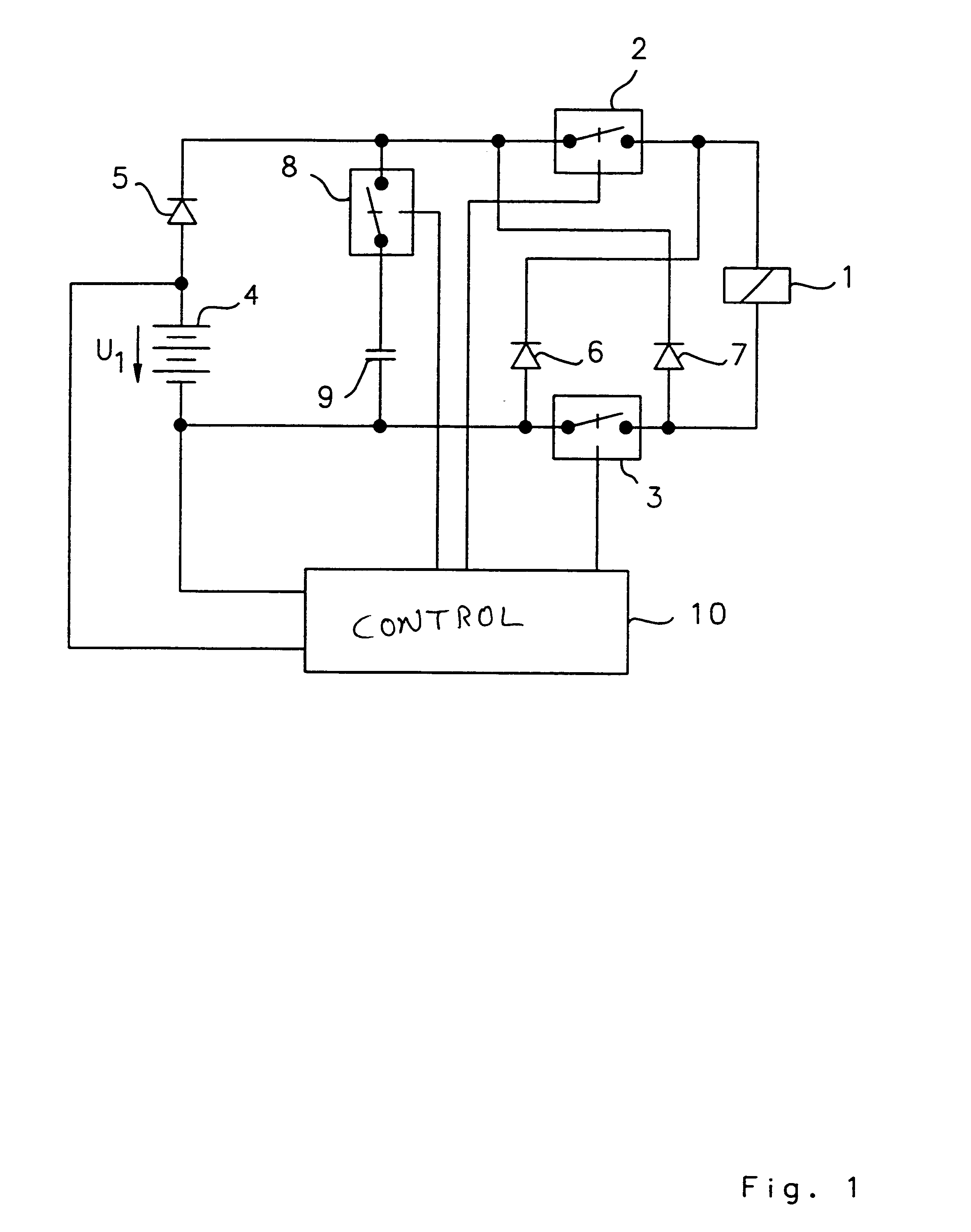Circuit arrangement for operating a solenoid actuator
a solenoid actuator and circuit arrangement technology, applied in emergency power supply arrangements, circuit-breaking switches, relays, etc., can solve the problems of reduced available voltage, battery failure, and relatively inefficient operation of motors of this type, and achieve the effect of high speed
- Summary
- Abstract
- Description
- Claims
- Application Information
AI Technical Summary
Benefits of technology
Problems solved by technology
Method used
Image
Examples
first embodiment
Referring now to the figures, and in particular FIG. 1, the invention is depicted, which is suitable for any type of solenoid actuator, such as, for example, solenoid valves, relays or electric motors. A solenoid actuator 1, is symbolically represented in FIG. 1, in the form of a relay coil.
The actuator 1 is connectable via a first switching device 2, 3 to an energy supply device 4, 5, 8, 9. The energy supply device 4, 5, 8, 9 is provided, in the depicted embodiment, with a battery 4, a diode 5, a switch 8 serving as a second switching device, and a capacitor 9 used as an energy storage. The battery 4 and the diode 5 serve as energy supply devices. The first switching device 2, 3 includes a first switch 2 and a second switch 3. The switches 2, 3 symbolize suitable electrical or electronic components with switching functions, such as, for example, semi-conductor switches, preferably field effect transistors. However, any kind of other component providing switching function can be use...
second embodiment
FIG. 2 shows the invention which is particularly well suited for the utilization of D.C. motors with a collector serving as the actuator, whereby the D.C. motor can be operated in both directions of rotation.
The first switching device, described with reference to FIG. 1 above, consists in this second embodiment of four switches 2, 3, 12, 13. In this case, the switches 2, 3 are arranged in a manner analogous with the circuit arrangement of FIG. 1. The switches 12, 13 are used to reverse the voltage polarity on the actuator I which, in this embodiment, is provided in the form of a D.C. motor 11. Therefore, either the switches 2, 3, or the switches 12, 13, are switched on, depending on the desired direction of rotation of the D.C. motor 11.
The energy feed-back arrangement consisting of the diodes 6, 7 in FIG. 1 includes an additional two diodes 14, 15 in the embodiment according to FIG. 2. The four diodes 6, 7, 14, 15 of the energy feed-back device are arranged in accordance with the e...
third embodiment
In FIG. 4, the invention is shown, which is particularly advantageous for use with the reluctance motor 18 described with respect to FIG. 3. In FIG. 4, only the exciter windings of the stator poles 21, 22, 23, 24, 31, 32, 33, 34, as well as the connecting conduits 37, 38 of the reluctance motor 18, are shown. The exciter windings are shown in the present embodiment in the form of individual coils or exciter windings 35 / 36, 43, 44, 45, for the sake of simplification.
In addition to the parts 4, 5, 6, 9, 16, 17 already explained with reference to FIGS. 1 and 2, the switches 2, 3, 12, 13, 39, 40 comprising the first switching device, and the diodes 6, 7, 14, 15, 41, 42 comprising the energy feed-back arrangement, are placed in this embodiment of the invention in a particularly advantageous manner, such that the expenditure in components is relatively lower than the complexity of the actuator 1, 18 employed in the embodiment. In particular, two switches and two diodes are not required fo...
PUM
 Login to View More
Login to View More Abstract
Description
Claims
Application Information
 Login to View More
Login to View More - R&D
- Intellectual Property
- Life Sciences
- Materials
- Tech Scout
- Unparalleled Data Quality
- Higher Quality Content
- 60% Fewer Hallucinations
Browse by: Latest US Patents, China's latest patents, Technical Efficacy Thesaurus, Application Domain, Technology Topic, Popular Technical Reports.
© 2025 PatSnap. All rights reserved.Legal|Privacy policy|Modern Slavery Act Transparency Statement|Sitemap|About US| Contact US: help@patsnap.com



